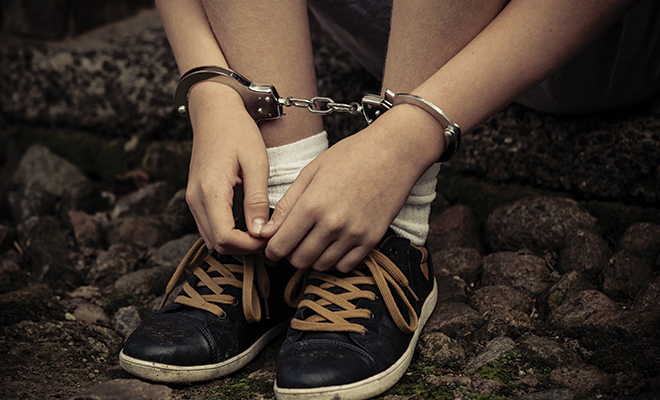
“I Am Not a Commodity:” The Fight against Human Trafficking
Every 30 seconds, someone becomes the victim of human trafficking. Shocking? Absolutely. What’s even more disturbing, human slavery is happening in 167 countries. Fifty-five percent of victims are women and girls; nearly one in five is a child.
How does it begin? Child abductions are frequently reported, but such incidents are not enough to lead to those statistics. In reality, experts believe that it begins innocently enough and the online world is the biggest culprit.
Human trafficking is a form of modern-day slavery, according to the Department of Homeland Security’s Blue Campaign. Any time a person is exploited for labor, which can mean anything from sex trafficking to domestic servitude, through force, fraud or coercion, it is considered human trafficking. What defines this term is consent, or lack thereof. Human trafficking is not the same as human smuggling, which means illegally moving someone across a border. Those being smuggled have given consent and are willingly participating. Those caught in the web of human trafficking have not given consent and have no power in their situation. Slavery is illegal in every single country in the world; nevertheless it exists and has a presence in every state.
The Formula for Fighting Back
As this crisis reaches epidemic proportions worldwide, organizations such as End It Movement, A21 and the National Human Trafficking Hotline have stepped forward to end human trafficking. Organizations such as Thorn, founded by Ashton Kutcher and Demi Moore in 2009, are using new technologies to locate missing and exploited children lost to the Dark Web, an area tech experts call “the internet’s underbelly.” The statistics are staggering, but there is hope.
Awareness
Predators lurk within online gaming sites, including popular games such as Minecraft and Roblox. Why? Because that’s where the kids are. Snapchat’s disappearing messages and Instagram’s Stories have been under fire as platforms where teens and tweens are particularly vulnerable to inappropriate or predatory behavior. Parents need to be aware of all platforms and programs their children spend time on and know their passwords. Frequent checks and conversations about what is and isn’t appropriate online behavior are vital. In a nutshell, parents and caregivers need to be vigilant and aware.
Prevention
Lack of awareness by parents and kids combined with an abundance of freedom and online connectivity often lead to dangerous situations. Kids have a perception of safety when they’re online because the majority of the time they are in their own home when using social media or online games. Parents need to know which games have a chat function and that even games intended for very young children can lead to private chat rooms and unrestricted internet sites that contain adult and illegal material. Parental blocking tools such as Net Nanny and NetSanity are available for iPads and iPhones; parents can also use YouTube’s parental blocking controls. Sites such as SafeSearchKids.com have other tips to keep kids safe online.
Rescue
In 2016, Thorn built a tool, called Spotlight, that can reduce investigative time for Dark Web abuse cases by 60 percent. Their web-based tool, now used by over 4,000 officers in 50 states, is actively helping to identify and locate more human trafficking victims, faster. Volunteer organizations such as Dream Center have services in place including an outreach program, an emergency hotline, networking with law enforcement and an emergency shelter to assist victims in escaping their situation.
Restoration
Restoration is the word given to the process of reintegration of survivors to new life that includes safety and aftercare. San Francisco’s Not for Sale organization created Reinvent, a program that is designed to prepare disconnected youth ages 18 to 24 who have been affected by trafficking, exploitation and related traumas for work in the Bay Area’s industries. These students attend four weeks of work-readiness training and life-skills coaching. Graduates of the program are placed in paid traineeships within Not for Sale’s network of Bay Area businesses.
If you suspect someone is in a human trafficking or human slavery situation, get help by calling the National Human Trafficking Hotline, 1-888-373-7888. Community members can use online tools such as Slavery Footprint to see how human trafficking exists in the services and products they consume. By supporting the efforts of non-profit organizations, criminal prosecutors and law enforcement, individuals in communities everywhere can do their part to raise awareness and be aware of something that is likely already occurring in their city. ■
Sources: dreamcenter.org, enditmovement.com, hulldailymail.co.uk, humantraffickinghotline.org, notforsalecampaign.org, ntdaily.com, restoreonelife.org, risinghopefoundation.org and wearethorn.org.
Resources for Parents
These sites can help parents keep kids safe and raise awareness about human trafficking.
– Truckers Against Trafficking educates the trucking and plaza industries and works with law enforcement. truckersagainsttrafficking.org.
– Galit Breen founded These Little Waves LLC to provide resources for parents and educators. theselittlewaves.net.
– Learn to turn on Safe Chat on Roblox. techwalla.com, search Roblox.
– Teach your kids about YAPPY and other online safety tactics. sixtimemommy.com.
– UNICEF provides excellent resources for talking with your children about human trafficking. Teachunicef.org, select option Child Trafficking.







